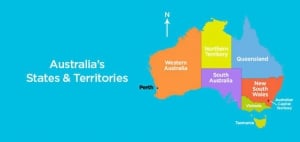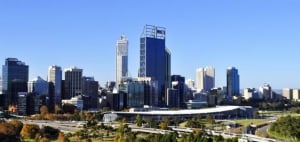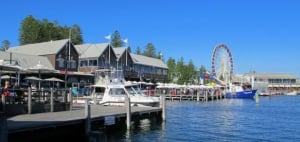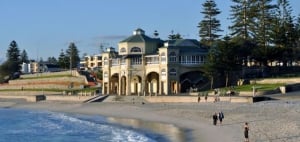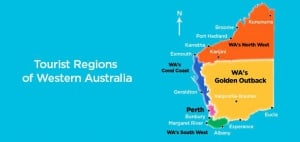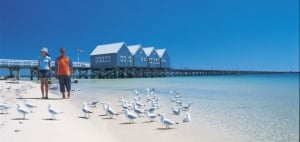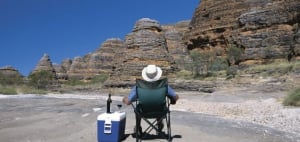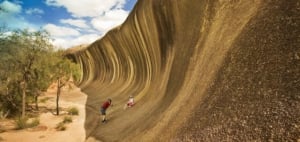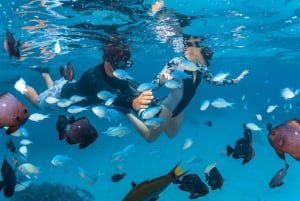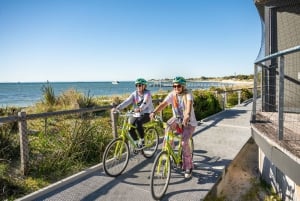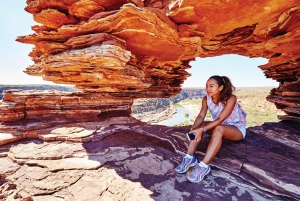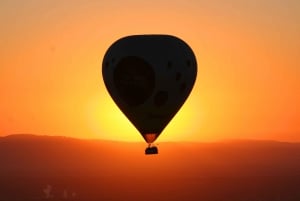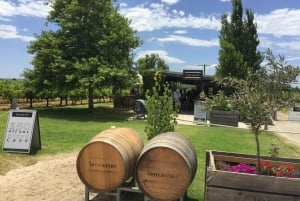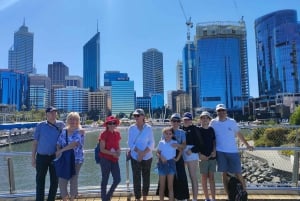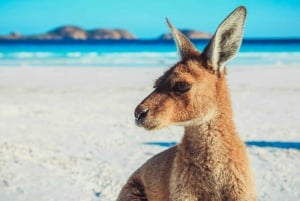WA Overview
G’day! Welcome to . Let us take you on an online guided tour of Western Australia (WA), the biggest state in Australia and one of the largest states in the world. It occupies approximately one third of this vast island continent. From Kununurra in the north to Albany in the south, Rottnest Island in the west to Eucla in the east, lie 2.5 million sq km of the most stunning scenery and unique fauna and flora found on Earth. With only 2.35 million people occupying this vast state, there’s plenty of room here in WA to travel for days without seeing another soul, or find yours to be the only pair of footprints on a pristine, white sand beach. So just imagine a mere 11% of Australia’s total population living in a state the size of Western Europe (about four times the size of Texas), and you’ll get the happy picture.
WA is not just a state with a stunning 12,889 km coastline bound by the turquoise blue Indian and Southern Oceans; nor is it merely a land blessed with an amazing biodiversity of plant and animal life, ancient rock formations and river gorges, strange beehive shaped hills, surreal lunar landscape, pink lakes, mysterious underground caves, multi-hued sand and world-class surf. It is much more than that. It is also home to a couple of increasingly vibrant cities so if you hard core urbanites need your fix of aromatic coffee, hip small bars, luxury designer stores and funky street-edgy shopping, then WA has that too. Perth, WA’s capital city and Fremantle, Perth’s historic port city with a cool vibe all of its own, can both offer you urban experiences quite different from anywhere else in the world.
Perth, WA’s capital city, is often described as ‘one of the world’s most isolated cities’. This is because its nearest city Adelaide, the capital city of South Australia, is 2692 km away by road. With the Indian and Southern Oceans on its left, and the vast Nullabor (which means "no trees") Plain on its right, Perth has long felt somewhat ‘separate’ from the rest of its sister cities on the east coast. Perth, being geographically closer to Jakarta (2776 km) and Bali (2578 km) than Canberra, Sydney and Brisbane, has always had an affinity for its South East Asian neighbours. WA is rich in resources and its mining boom has also led to an influx of foreigners in recent years. WA achieved the status of being the nation’s economic powerhouse and its success contributed to the Australian economy being kept afloat during the recent Global Financial Crisis. Perth has a population of about 1.8 million and is a multicultural and diverse hub. At least one third of its population are first generation migrants from all over the world. Casual, laid-back, unpretentious, tough, fiercely independent, and friendly are some of the adjectives that often roll off the tongue when one tries to describe Perth and its people. In summary, due to its geographical isolation yet multicultural diversity, new found economic prosperity but continued humility, increasingly cool vibe yet relaxed ambience, Perth has a ‘feel’ about it that is quite unlike any other Australian city. One brief visit will not be enough for the traveler who truly wants to get to know this seemingly simple city better.
Fremantle, Perth’s swinging historical port city, has a completely different vibe from Perth and Fremantle’s inhabitants are passionately proud of this. In fact, many consider their beloved "Freo" to be quite distinct and separate from their own capital city. Fremantle lies 19 km to the south of Perth and its ideal location at the mouth of the Swan River was a factor in its establishment as a port. It still operates as a major port and is a favourite travel destination of many cruise ship passengers. Fremantle is well known for its historical buildings, many of which are well preserved and have heritage status. One of these buildings is the famous (or infamous) Fremantle Prison which was built in the 1850’s and acquired UNESCO World Heritage status in 2010. It ceased operating as a prison in 1991 and is now a fascinating tourist attraction, with its highly acclaimed tunnel and spooky torchlight tours continuing to enthral its visitors week after week. Fremantle is also famous as an arts, cultural and music hub. For a city with only a population of approximately 25 000, Freo seems to have produced more than its fair share of talented artists, musicians and performers. It has many art galleries, museums and live music venues to entertain you. Freo also has other distractions such as its markets, quirky shops, micro breweries, cafes and restaurants to keep you very happy.
A little further away from Perth’s city centre are the deservedly famous weekend retreats and ‘playgrounds’ of many locals. The 50 km long Sunset Coast, which stretches from Cottesloe Beach (20 minutes from Perth city centre) to Two Rocks, comprises 19 metropolitan beaches that seem to stretch on and on. Water sports enthusiasts and those who just want to relax by the beach will enjoy the choices that the Sunset Coast has to offer. It will take you only about 25 minutes to reach the Swan Valley, which is WA’s oldest wine growing region. This pretty valley is brimming with grape growing vineyards, boutique local produce providers, gourmet restaurants, an interactive wildlife park, a world class golf resort, micro breweries, cafes and award winning wineries. Armadale is about 45 minutes southeast of Perth city and its beautiful botanic park and scenic golf course are among two of its many delights. Next is the scenic Avon Valley which lies east of Perth. Here you can relax among historical villages, quaint little shops and cafes. Mandurah & Peel are about an hour’s drive south of Perth and you’ll find tons of water based and land based activities to keep you occupied. Mandurah is a picturesque seaside city that boasts many canals and waterways. The neighbouring Peel region features historical towns, many lovely parks and forests that have scenic walk and bike trails. If an island paradise is more your cup of tea, then we suggest at least a full day’s outing at Rottnest Island which lies 19 km off the coast of WA. Water activities and scenic flight tours are two of its highlights.
For the convenience of travelers, WA has been categorised into 5 tourist regions, each offering its own distinct sights and adventures. Visitors will be totally spoilt for choice. First, there is Perth with its vibrant city and diverse suburbs. Next, the greener and cooler environs of the South West region beckon with its world-class wineries and gourmet restaurants. Just north of the Perth region lies the ocean lined Coral Coast region that boasts two World Heritage sites; then there is the rugged and ancient land of WA’s North West with its rich indigenous history, unique rock formations, and World Heritage listed beehive shaped towers. Finally, WA’s Golden Outback offers visitors a trip into WA’s gold mining past and present, and some of the world’s best white sand beaches.
(Photo of Busselton Jetty courtesy of Tourism Western Australia)
WA’s South West region is a magnificent wonderland of award winning wineries, gourmet restaurants, boutique local food providers, world-famous surf breaks, tranquil forests, historic homesteads, beautiful spring flower ( more than 8000 species), limestone caves, rugged coastline, stunning beaches and many other delights that are simply too numerous to name. With such a plethora of things to see and do, it is no wonder that Lonely Planet voted WA’s beautiful South West as one of the world’s top ten places to visit in 2010. Here are just some of the most memorable experiences you can enjoy in the South West: taste your way through the internationally acclaimed wineries at the world famous Margaret River Wine Region. Eat at the many fine restaurants that specialise in creating dishes showcasing the South West’s excellent local produce. Marvel at the pieces created by the abundant talent displayed in this inspiring region’s art galleries and studios. Walk through the ancient karri forests of Pemberton or wander amongst the canopy of trees at the 40 metre high Tree Top Walk between Walpole and Denmark. You can also take a train ride or walk on Busselton’s 147 year old timber jetty which is almost 2 km long. Tour the isolated lighthouses near Dunsborough and Augusta or get to know the friendly dolphins at Bunbury. If you want to see something bigger, then hop on a boat and enjoy the awesome sight of the migrating whales breeching or coming up for air. And to top that, catch the perfect wave, the stuff that legends are made of, at one of this region’s famous surfing breaks.
(Photo of whale shark and diver courtesy of Tourism Western Australia)
WA’s spectacular Coral Coast begins from the seaside town of Cervantes, and stretches for more than 1000 km north to the fishing wonderland of Exmouth. It is here on the Coral Coast where you can view stark contrasts of landscapes and experience an unbelievably diverse range of activities, some of which are truly bucket list worthy. Highlights of the Coral Coast include the surreal lunar-like landscape of the Pinnacles, the UNESCO World Heritage listed sites of Shark Bay and the Ningaloo Coast where one WA’s iconic experiences can be had – a swim with the world’s largest fish, the gentle whale shark. In addition, there are the prehistoric stromatolites at Hamelin Bay, aptly named Shell Beach,and the city of Geraldton with its excellently presented museum. Nature in all her full glory can also be seen and experienced here along the Coral Coast. Throughout the year, various natural seasonal activities take place ranging such as coral spawning, the annual migration of Humpback Whales and turtle breeding to the blossoming of WA’s spectacular spring wildflowers in various pockets of the countryside.
(Photo of Bungle bungles courtesy of Tourism Western Australia)
Many travelers who have explored WA’s raw and rugged North West have described the Pilbara and Kimberley regions as being the ‘real deal’. This tough, remote and often harsh environment encapsulates what many feel is the true essence, the soul of Western Australia and some would even say Australia itself. The rewards are enormous for the traveler who takes the time and effort to explore this area of stark contrasts and truly amazing beauty. With perhaps the exception of its more famous sister, Uluru (formerly known as Ayers Rock), there is quite possibly no other natural landmark in Australia that will stir your soul the way the UNESCO World Heritage listed Purnululu National Park will. And of course there are the indescribably stunning patterns, colours and textures of Pilbara’s Karijini National Park - yet another bucket list worthy item not to be missed. For those who prefer their creature comforts, Broome, WA’s historical pearling centre and a pretty seaside town to boot, is another North Western highlight to be enjoyed. You can also cruise down the Ord River and Lake Argyle, Australia’s largest fresh water lake, or marvel at the world famous Horizontal Waterfalls on the Buccaneer Archipelago. Then there is the much photographed natural phenomenon, known as the ‘staircase to the moon’ that occurs during certain times of the year. And if you really want to understand Australia, we suggest taking a fascinating indigenous tour lead by a local guide who will gladly share his art, culture, stories, beliefs and the way of life of his people, Australia’s first inhabitants.
(Photo of Wave Rock courtesy of Tourism Western Australia)
WA’s Golden Outback occupies just over half of the state. It is an area filled with a variety of contrasts such as historical towns populated with heritage buildings, ghost towns, red dusty plains, pristine white beaches, turquoise blue oceans, seemingly endless wheat fields and vibrant spring wildflowers that cover large tracts of this region. It is also the place where one can gain some insights into WA’s early pioneering spirit and the history of the gold mining industry. You can peer into the Kalgoorlie Super Pit where huge trucks look like tiny toys as they wind their way around the curves of the massive Super Pit. Visit Kalgoorlie-Boulder where the spirit of old Wild West still runs through its historical buildings, pubs and museum. Wander around the fifty one life-size Antony Gormley Sculptures at lonely Lake Ballard. You can also play on a 1,365 km long 18 hole golf course that spans from Kalgoorlie to Ceduna in South Australia. And at Lucky Bay in the pretty seaside town of Esperance, you might even find yourself sharing Australia’s best white sand beach with a kangaroo or two. And if you love massive rocks then Hyden’s Wave Rock and Mount Augustus should please you no end.
If you intend to explore more of this huge state (which is about the size of Western Europe), thorough research, planning and preparation is vital. Take a look at our weather and events pages for some tips. It would also be wise to allocate more than enough time to get to your destinations so that you can enjoy your trip and not end up rushing around. It is far too easy to underestimate the time needed to travel when one only has a map to refer to. Road distances, traffic conditions, weather considerations and other factors can affect driving time estimates considerably. If you really want to enjoy WA, it’s best to take things leisurely and plan accordingly in order to get the best out of this vast, laid-back land. So relax, chill out and just enjoy the ride.



